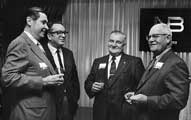

Art Semmig, Joy Boys engineer
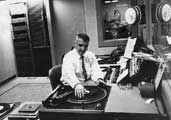 WRC engineer Art Semmig was one of the first Joy Boys engineers.
In this story we'll show you what life was like from his
side of the soundproof glass, and also a bit about
a recording engineer's career from the 1940s and '50s.
(Click any picture for a larger view.)
WRC engineer Art Semmig was one of the first Joy Boys engineers.
In this story we'll show you what life was like from his
side of the soundproof glass, and also a bit about
a recording engineer's career from the 1940s and '50s.
(Click any picture for a larger view.)
This series of pictures is from around 1960.
We see Art in the control room,
Willard Scott sitting close to the glass,
and Ed Walker at the center table in Studio One. Ed is holding up
his hand, ready to signal Art to play the next record or commercial.
Both music and commercial spots were recorded on discs called "E. T.'s"
(electrical transcriptions). Tape recordings weren't yet commonly
used for playback during on-air broadcasts.
Click here
(MP3 file, 104K)
to hear a Mac McGarry promo, followed by Willard saying
"Mac, that was you on the E. T., right?"
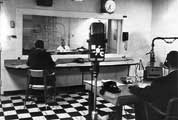
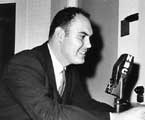
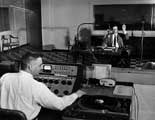
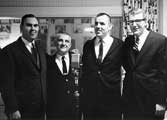 Willard Scott, Art Semmig, Ed Walker, and John Hickman pose
in the studio. John worked with the Joy Boys for many years as a producer,
and also hosted the Big Broadcast on WAMU-FM before retiring due to illness.
Ed Walker then began hosting that show on Sunday nights.
Willard Scott, Art Semmig, Ed Walker, and John Hickman pose
in the studio. John worked with the Joy Boys for many years as a producer,
and also hosted the Big Broadcast on WAMU-FM before retiring due to illness.
Ed Walker then began hosting that show on Sunday nights.
The Joy Boys always thanked their engineers at the end of the show.
Click here
(MP3 file, 68K)
to hear one of those occasions. Ed says "look at the birdie,"
referring to the fact that Art Semmig liked to carry his camera
and made lots of photographs around WRC.
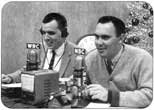 You can also listen to this clip
(MP3 file, 90K)
as the Joy Boys were broadcasting live from the WRC lobby in December 1966,
and Ed speaks to Art (who is still in the control room, in the basement).
You can also listen to this clip
(MP3 file, 90K)
as the Joy Boys were broadcasting live from the WRC lobby in December 1966,
and Ed speaks to Art (who is still in the control room, in the basement).
Click here (MP3 file, 138K) to hear Willard and Ed reminisce about Art's shape and his famous snoring! This sound clip is from our first Remember the Joy Boys CD project.
 In 1944, the magazine Radio News (later Radio-TV News) ran an article
describing the equipment used by the Library of Congress to preserve
old recordings. In 1944, "preserve" meant "transfer from wax cylinder
and cut a disc." Art Semmig was involved in this project and he appeared
in the article. Below we see Art operating the necessary
equipment:
(left) playing a cylinder;
(center) closeup of the dubbing table, with its control board,
filters, and equalizers;
(right) the complete recording setup which includes
two Scully recording machines, two Presto 6N recording machines,
RCA high-fidelity amplifiers, Presto recording amplifiers,
Fairchild playback tables, and Hallicrafters S-31 and SX-28 receivers.
In 1944, the magazine Radio News (later Radio-TV News) ran an article
describing the equipment used by the Library of Congress to preserve
old recordings. In 1944, "preserve" meant "transfer from wax cylinder
and cut a disc." Art Semmig was involved in this project and he appeared
in the article. Below we see Art operating the necessary
equipment:
(left) playing a cylinder;
(center) closeup of the dubbing table, with its control board,
filters, and equalizers;
(right) the complete recording setup which includes
two Scully recording machines, two Presto 6N recording machines,
RCA high-fidelity amplifiers, Presto recording amplifiers,
Fairchild playback tables, and Hallicrafters S-31 and SX-28 receivers.
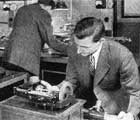
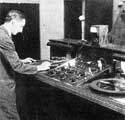
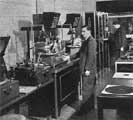
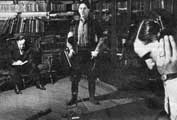 Now, imagine that same roomfull of equipment stuffed in a truck
and taken on location for remote recordings.
These two pictures are from the St. Louis Post-Dispatch,
February 23 1947, an article entitled "Singing Miners:
They record their folk ballads for Library of Congress."
The first picture was captioned
At recording session in basement of public library at Pottsville,
Pennsylvania, miner Bill Kating sings a folk ballad of the
anthracite region. It was appropriately titled "Down, Down, Down."
Seated at left is George Korson, supervisor of the Library of Congress
recording project. Arthur Semmig, right, traveled through region
in station wagon.
Now, imagine that same roomfull of equipment stuffed in a truck
and taken on location for remote recordings.
These two pictures are from the St. Louis Post-Dispatch,
February 23 1947, an article entitled "Singing Miners:
They record their folk ballads for Library of Congress."
The first picture was captioned
At recording session in basement of public library at Pottsville,
Pennsylvania, miner Bill Kating sings a folk ballad of the
anthracite region. It was appropriately titled "Down, Down, Down."
Seated at left is George Korson, supervisor of the Library of Congress
recording project. Arthur Semmig, right, traveled through region
in station wagon.
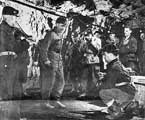 Russell David, mine superintendant, does a clog dance at a recording
session in one of the mines. Fiddler at left is James Muldowney,
mine carpenter. He made his violin. Korson and Semmig wear miners' clothing.
Russell David, mine superintendant, does a clog dance at a recording
session in one of the mines. Fiddler at left is James Muldowney,
mine carpenter. He made his violin. Korson and Semmig wear miners' clothing.
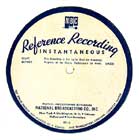 Recording on a disc was very much a one-shot deal, much like burning a
CD-R is today. But of course there was much more
room for a label! Here's an example of the labels you might see
on a disc, just after it was recorded at NBC.
Recording on a disc was very much a one-shot deal, much like burning a
CD-R is today. But of course there was much more
room for a label! Here's an example of the labels you might see
on a disc, just after it was recorded at NBC.
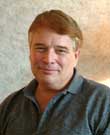 Thanks to Bob Semmig
for the photos and background material used in this story,
borrowed from his father's collection.
Thanks to Bob Semmig
for the photos and background material used in this story,
borrowed from his father's collection.
Home | History | Audio | Pictures | Tales | Links | Contact Us
